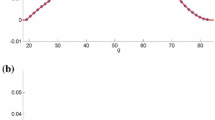Abstract
Recently Dalgaard and Strulik have proposed (in Resour. Energy Econ. 33:782–797, 2011) an energy model of capital accumulation based on the mathematical framework developed by Solow-Swan and coupled with Cobb-Douglas production function (Solow in Q. J. Economics 70:65–94, 1956; Swan in Econ. Rec. 32(63):334–361, 1956). The model is based on a constant rate of population growth assumption. The present paper, according to the analysis performed by Yukalov et al. (Physica D 238:1752–1767, 2009), improves the Dalgaard-Strulik model by introducing a logistic-type equation with delayed carrying capacity which alters the asymptotic stability of the relative steady state. Specifically, by choosing the time delay as a bifurcation parameter, it turns out that the steady state loses stability and a Hopf bifurcation occurs when time delay passes through critical values. The results are of great interest in the applied and theoretical economics.
Similar content being viewed by others
References
Baker, C.T.H., Bocharov, G.A., Paul, C.A.H.: Mathematical modelling of the interleukin-2 T-cell system: a comparative study of approaches based on ordinary and delay differential equations. J. Theor. Med. 2, 117–128 (1997)
Banavar, J.R., Maritan, A., Rinaldo, A.: Size and form in efficient transportation networks. Nature 399, 130–132 (1999)
Banks, R.B.: Growth and Diffusion Phenomena: Mathematical Frameworks and Applications. Springer, Berlin (1994)
Bianca, C.: Mathematical modelling for keloid formation triggered by virus: malignant effects and immune system competition. Math. Models Methods Appl. Sci. 21, 389–419 (2011)
Bianca, C.: Kinetic theory for active particles modelling coupled to Gaussian thermostats. Appl. Math. Sci. 6, 651–660 (2012)
Bianca, C.: An existence and uniqueness theorem to the Cauchy problem for thermostatted-KTAP models. Int. J. Math. Anal. 6, 813–824 (2012)
Bianca, C.: Onset of nonlinearity in thermostatted active particles models for complex systems. Nonlinear Anal., Real World Appl. 13, 2593–2608 (2012)
Bianca, C.: Modeling complex systems by functional subsystems representation and thermostatted-KTAP methods. Appl. Math. Inf. Sci. 6, 495–499 (2012)
Bianca, C.: Thermostatted kinetic equations as models for complex systems in physics and life sciences. Phys. Life Rev. 9, 359–399 (2012)
Bianca, C.: Existence of stationary solutions in kinetic models with Gaussian thermostats. Math. Methods Appl. Sci. (2013). doi:10.1002/mma.2722
Bianca, C., Pennisi, M.: The triplex vaccine effects in mammary carcinoma: a nonlinear model in tune with simtriplex. Nonlinear Anal., Real World Appl. 13, 1913–1940 (2012)
Bianca, C., Ferrara, M., Guerrini, L.: Hopf bifurcations in a delayed-energy-based model of capital accumulation. Appl. Math. Inf. Sci. 7, 139–143 (2013)
Bianca, C., Ferrara, M., Guerrini, L.: The Cai model with time delay: existence of periodic solutions and asymptotic analysis. Appl. Math. Inf. Sci. 7, 21–27 (2013)
Bucci, A., Guerrini, L.: Transitional dynamics in the Solow-Swan growth model with AK technology and logistic population change. B E J. Macroecon. 9, 1–16 (2009)
Dalgaard, C.L., Strulik, H.: Energy distribution and economic growth. Resour. Energy Econ. 33, 782–797 (2011)
Ferrara, M.: Demographic dynamics and green economy: a sustainable growth model. Istituto Lombardo (Rend. Lett.) 143, 447–468 (2009)
Ferrara, M.: An AK Solow model with logistic law technology. Int. J. Pure Appl. Math. 67, 337–340 (2011)
Ferrara, M.: A note on the Solow economic growth model with Richards population growth law. Appl. Sci. 13, 36–39 (2011)
Ferrara, M., Guerrini, L.: On the dynamics of a three sector growth model. Int. Econ. Rev. 55, 275–283 (2008)
Galor, O.: From stagnation to growth: unified growth theory. In: Aghion, P., Durlauf, S. (eds.) Handbook of Economic Growth, vol. 1A. North-Holland, Amsterdam (2005)
Guerrini, L.: The Solow-Swan model with a bounded population growth rate. J. Math. Econ. 42, 14–21 (2006)
Guerrini, L.: The Ramsey model with a bounded population growth rate. J. Macroecon. 32, 872–878 (2010)
Guerrini, L.: The Ramsey model with AK technology and a bounded population growth rate. J. Macroecon. 32, 1178–1183 (2010)
Guerrini, L.: A closed-form solution to the Ramsey model with logistic population growth. Econ. Model. 27, 1178–1182 (2010)
Guerrini, L.: Transitional dynamics in the Ramsey model with AK technology and logistic population change. Econ. Lett. 109, 17–19 (2010)
Hassard, B., Kazarino, D., Wan, Y.: Theory and Application of Hopf Bifurcation. Cambridge University Press, Cambridge (1981)
Hutchinson, G.E.: Circular causal systems in ecology. Ann. N.Y. Acad. Sci. 50, 221–246 (1948)
Kühnert, C., Helbing, D., West, G.: Scaling laws in urban supply networks. Physica A 363, 96–103 (2006)
Malthus, T.R.: An Essay on the Principle of Population. Oxford World’s Classics. Oxford University Press, Oxford (1999)
Ramsey, F.P.: A mathematical theory of saving. Econ. J. 38, 543–559 (1928)
Solow, R.M.: A contribution to the theory of economic growth. Q. J. Econ. 70, 65–94 (1956)
Swan, T.W.: Economic growth and capital accumulation. Econ. Rec. 32(63), 334–361 (1956)
Verhulst, P.F.: Notice sur la loi que la population suit dans son accroissement. Corresp. Math. Phys. 10, 113–121 (1838)
Wright, E.M.: A non-linear difference-differential equation. J. Reine Angew. Math. 194, 66–87 (1955)
Yukalov, V.I., Yukalova, E.P., Sornette, D.: Punctuated evolution due to delayed carrying capacity. Physica D 238, 1752–1767 (2009)
Author information
Authors and Affiliations
Corresponding author
Rights and permissions
About this article
Cite this article
Bianca, C., Guerrini, L. On the Dalgaard-Strulik Model with Logistic Population Growth Rate and Delayed-Carrying Capacity. Acta Appl Math 128, 39–48 (2013). https://doi.org/10.1007/s10440-013-9800-0
Received:
Accepted:
Published:
Issue Date:
DOI: https://doi.org/10.1007/s10440-013-9800-0




